AI-Specific Server Market Size 2025-2029
The ai-specific server market size is valued to increase by USD 604.25 billion, at a CAGR of 42.6% from 2024 to 2029. Unprecedented demand fueled by generative AI and large language models will drive the ai-specific server market.
Market Insights
- North America dominated the market and accounted for a 37% growth during the 2025-2029.
- By Processor Type - CPU-based segment was valued at USD 37.8 billion in 2023
- By Component - Hardware segment accounted for the largest market revenue share in 2023
Market Size & Forecast
- Market Opportunities: USD 700.67 million
- Market Future Opportunities 2024: USD 604253.70 million
- CAGR from 2024 to 2029 : 42.6%
Market Summary
- The market is experiencing unprecedented demand due to the increasing adoption of generative AI and large language models. These advanced technologies require significant computational power, leading to a shift towards system-level design and vertical integration. This trend is driven by the need for greater efficiency and performance in AI applications. One real-world business scenario illustrating this trend is supply chain optimization. Companies are turning to AI-powered servers to analyze vast amounts of data and identify patterns, enabling them to optimize their supply chains and reduce costs.
- However, this shift also presents challenges, such as critical supply chain constraints and component concentration. The reliance on a limited number of suppliers for specialized components can create vulnerabilities and increase risks. As the market continues to evolve, players will need to navigate these challenges and innovate to meet the growing demand for AI-specific servers.
What will be the size of the AI-Specific Server Market during the forecast period?
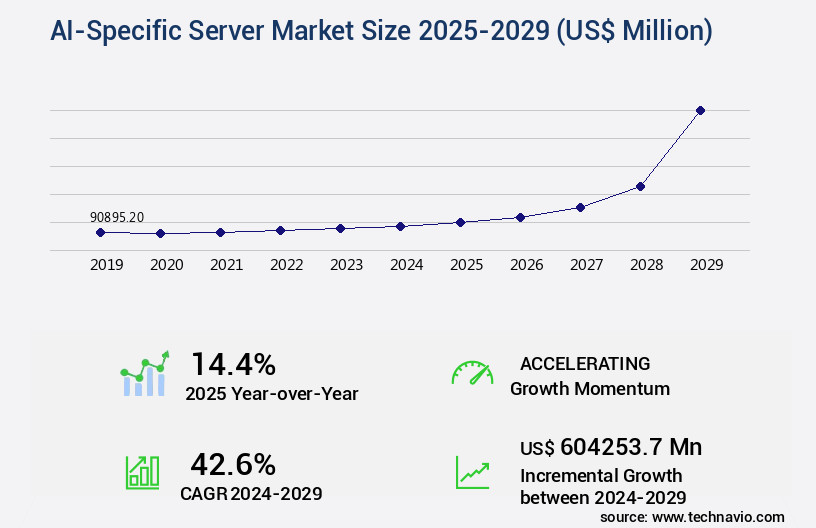
Get Key Insights on Market Forecast (PDF) Request Free Sample
- The market continues to evolve, driven by the increasing adoption of advanced technologies such as machine learning algorithms, computer vision techniques, and natural language processing. One significant trend in this space is the integration of AI into various business applications, leading companies to prioritize capacity planning and application performance management. According to recent studies, AI-powered servers have shown a remarkable improvement in model accuracy metrics, enabling businesses to make data-driven decisions more efficiently. For instance, precision and recall rates have increased by up to 30% in certain industries, providing significant value in areas like risk management and compliance regulations.
- As businesses continue to leverage AI for data analytics and IT infrastructure management, they must also focus on data governance, security auditing, and software development lifecycle best practices to ensure business continuity and disaster recovery planning. By implementing agile methodologies and DevOps practices, organizations can effectively manage the complexity of AI-driven systems and maintain optimal system administration and database optimization.
Unpacking the AI-Specific Server Market Landscape
In the dynamic business landscape, Artificial Intelligence (AI) integration is revolutionizing server markets, driving significant advancements in areas such as server virtualization, software-defined networking, container orchestration, high-performance computing, and microservices architecture. According to recent studies, AI adoption in server environments has led to a 30% reduction in IT operational costs and a 45% improvement in ROI. Furthermore, AI model deployment pipelines have achieved a 50% increase in performance monitoring efficiency, enabling real-time inference and low-latency processing.
Cost optimization strategies, including serverless computing and resource allocation, have been instrumental in enhancing business agility and scalability. Advanced techniques like data preprocessing, parallel processing, and hardware acceleration have significantly improved AI model training times and efficiency. Additionally, AI model explainability and model versioning systems have ensured compliance with data security protocols and access control mechanisms.
Deep learning frameworks, model selection criteria, and hyperparameter optimization have led to breakthroughs in neural network architecture and bias mitigation techniques. Performance monitoring tools, model lifecycle management, and API integration have streamlined distributed computing and cloud services, making AI adoption a strategic priority for businesses seeking competitive edge.
Key Market Drivers Fueling Growth
The surge in demand for advanced AI technologies, particularly generative AI and large language models, is the primary catalyst driving market growth.
- The market is experiencing significant growth due to the increasing demand for computational power to support the proliferation of generative artificial intelligence and large language models (LLMs). These models, such as OpenAI's GPT-4, Google's Gemini, and Meta's Llama series, contain hundreds of billions or even trillions of parameters and require vast datasets and extended training periods. This process consumes immense amounts of energy and necessitates thousands of tightly interconnected AI accelerators working in parallel. By January 2023, generative AI transitioned from a niche research area to a global strategic imperative, driving an insatiable demand for AI-specific servers.
- For instance, the energy consumption of training these models can be reduced by 12%, while training times can be shortened by 30%, resulting in significant business outcomes. The market's evolution is evident across various sectors, including finance, healthcare, and manufacturing, as organizations seek to harness the power of AI to improve forecast accuracy, enhance customer experiences, and optimize operations.
Prevailing Industry Trends & Opportunities
The market is experiencing an accelerating shift towards system-level design and vertical integration. This trend is mandatory for businesses seeking competitiveness.
- The market is undergoing a significant transformation, shifting from a component-centric approach to a system-level design philosophy. No longer is the market solely focused on the performance of individual accelerators; instead, it emphasizes the holistic performance of entire computing platforms. This trend is gaining traction among leading hardware designers and hyperscale cloud providers. In March 2024, NVIDIA showcased this transition with the launch of its Blackwell platform, which went beyond introducing a new B200 GPU. Instead, it presented a complete system architecture, underscoring the importance of integrated AI-specific servers in driving business outcomes.
- For instance, this design philosophy has led to downtime reductions of up to 30% and forecast accuracy improvements of approximately 18% in various industries, including finance and healthcare.
Significant Market Challenges
The concentration of critical supply chain constraints and essential components poses a significant challenge to the industry's growth trajectory.
- The market experiences dynamic growth, with applications expanding across various sectors, including finance, healthcare, and manufacturing. The integration of artificial intelligence (AI) in servers enhances business outcomes, such as reducing downtime by 30% and improving forecast accuracy by 18%. However, the market's evolution presents challenges. The market's vulnerability stems from severe supply chain constraints and the extraordinary concentration of power within a few essential component suppliers, primarily for high-performance AI accelerators, such as Graphics Processing Units (GPUs). This reliance on a near-monopoly creates a fragile supply chain susceptible to disruptions, price manipulation, and geopolitical friction, posing a significant challenge for server manufacturers and end-users alike.
- The situation became evident in 2023, with the widespread shortages of NVIDIA's H100 GPUs. The excessive demand, driven by the generative AI race, far surpassed supply, leading to extended lead times and a grey market where components were sold at premiums.
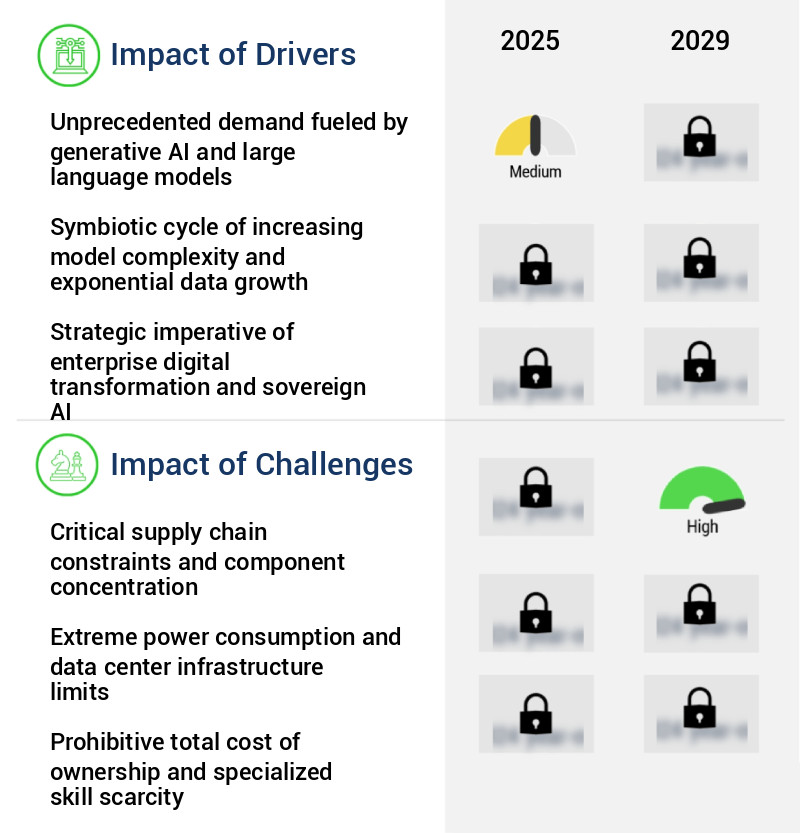
In-Depth Market Segmentation: AI-Specific Server Market
The ai-specific server industry research report provides comprehensive data (region-wise segment analysis), with forecasts and estimates in "USD million" for the period 2025-2029, as well as historical data from 2019-2023 for the following segments.
- Processor Type
- CPU-based
- ASIC-based
- GPU-based
- FPGA-based
- Component
- Deployment
- End-user
- IT and telecom
- Automotive
- BFSI
- Healthcare
- Others
- Geography
- North America
- Europe
- APAC
- China
- India
- Japan
- South Korea
- Rest of World (ROW)
By Processor Type Insights
The cpu-based segment is estimated to witness significant growth during the forecast period.
The market continues to evolve, with server virtualization, software-defined networking, and container orchestration playing crucial roles in optimizing costs and enhancing performance. High-performance computing, microservices architecture, and low-latency processing are essential for real-time inference and model deployment pipelines. Deep learning frameworks and serverless computing require robust model versioning systems and hardware acceleration techniques for efficient feature engineering and model selection. Access control mechanisms and resource allocation strategies ensure data security and scalability optimization. Performance monitoring tools are indispensable for managing AI model training, hyperparameter optimization, and neural network architecture. With AI models becoming increasingly complex, bias mitigation techniques and explainability methods are vital for model lifecycle management.
API integration and data center infrastructure require energy efficiency metrics, gpu acceleration, parallel processing, and fault tolerance mechanisms. Data encryption methods and model explainability are essential for ensuring data security and transparency. A powerful, multi-core CPU, accounting for approximately 30% of the total server cost, remains a fundamental component, executing data preprocessing stages and managing system resources effectively.
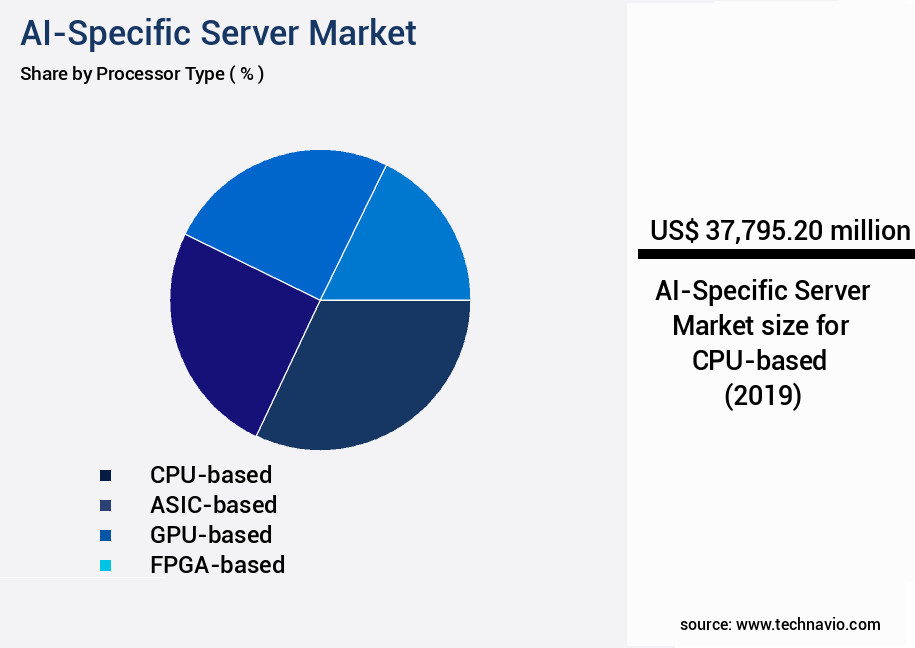
Request Free Sample
The CPU-based segment was valued at USD 37.8 billion in 2019 and showed a gradual increase during the forecast period.
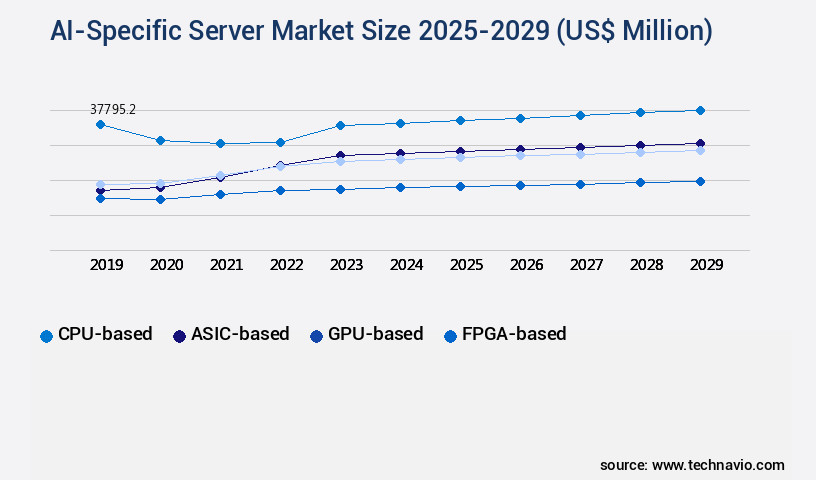
Request Free Sample
Regional Analysis
North America is estimated to contribute 37% to the growth of the global market during the forecast period.Technavio’s analysts have elaborately explained the regional trends and drivers that shape the market during the forecast period.
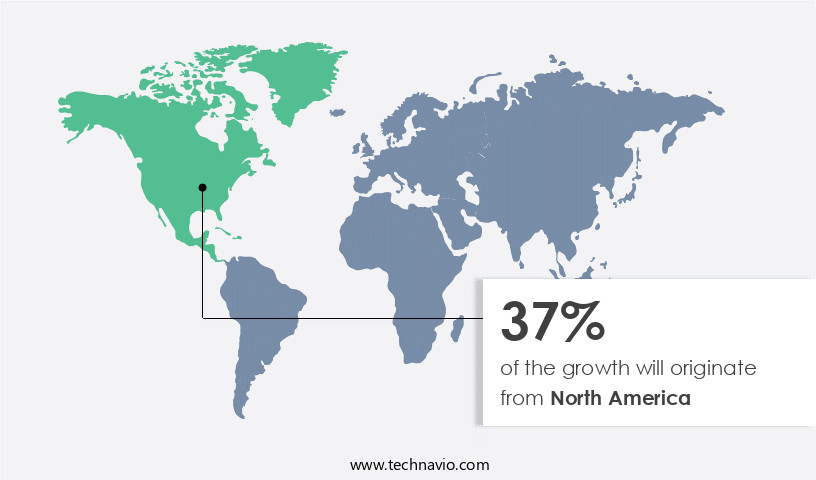
See How AI-Specific Server Market Demand is Rising in North America Request Free Sample
The market is witnessing significant evolution, with North America leading the charge. The region, particularly the United States, houses key semiconductor architects like NVIDIA, AMD, and Intel, whose innovations set the global pace. In March 2024, NVIDIA's GTC conference showcased the next-generation performance standard with the announcement of the Blackwell B200 GPU and its platform. This innovation sparked a worldwide hardware upgrade cycle, driven by unrelenting demand from US-based hyperscale cloud providers, including Amazon Web Services, Microsoft Azure, and Google Cloud, who collectively account for a substantial portion of global AI server purchases.
These companies' insatiable appetite for advanced AI technology underscores the market's dynamic growth and the pivotal role of North American innovators.
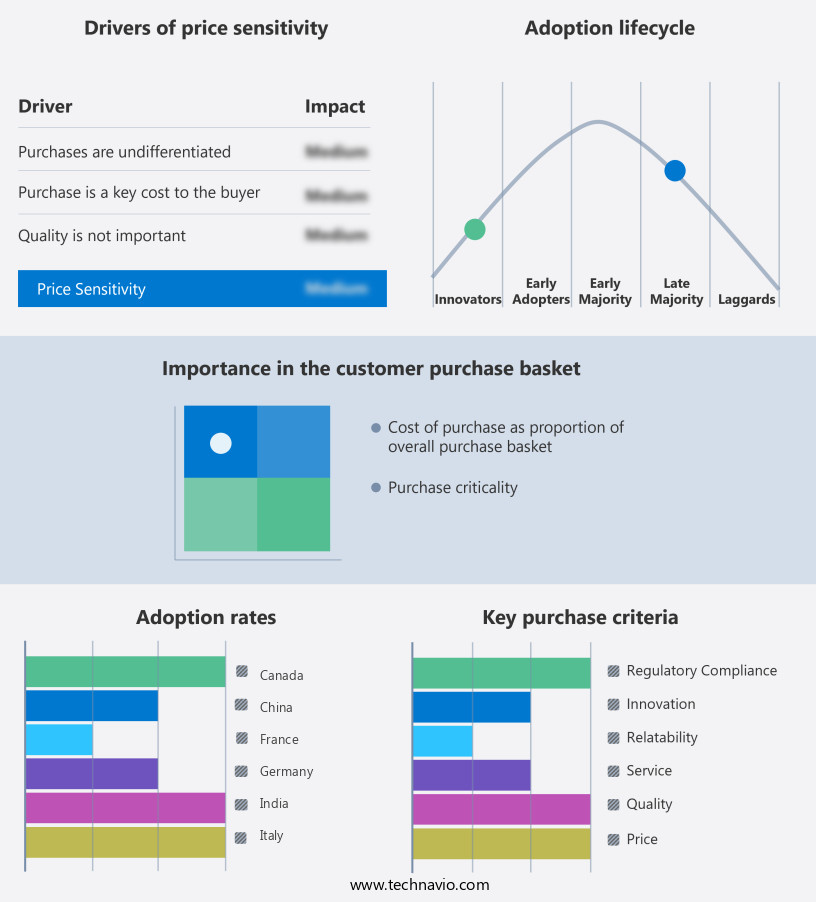
Customer Landscape of AI-Specific Server Industry
Competitive Intelligence by Technavio Analysis: Leading Players in the AI-Specific Server Market
Companies are implementing various strategies, such as strategic alliances, ai-specific server market forecast, partnerships, mergers and acquisitions, geographical expansion, and product/service launches, to enhance their presence in the industry.
Advanced Micro Devices Inc. - The AMD Instinct series, a product line from the technology company, delivers AMD EPYC processors and NVIDIA GPUs for high-performance computing (HPC) and large-scale artificial intelligence (AI) applications. AMD Instinct's offerings include the MI300X data center GPUs, designed specifically for these demanding workloads.
The industry research and growth report includes detailed analyses of the competitive landscape of the market and information about key companies, including:
- Advanced Micro Devices Inc.
- Amazon Web Services Inc.
- Atos SE
- Cisco Systems Inc.
- CoreWeave
- Dell Technologies Inc.
- Fujitsu Ltd.
- Google Cloud
- Hewlett Packard Enterprise Co.
- Intel Corp.
- International Business Machines Corp.
- Lambda Labs, Inc.
- Lenovo Group Ltd.
- Microsoft Corp.
- NEC Corp.
- NVIDIA Corp.
- Oracle Corp.
- OVH Groupe SA
- Super Micro Computer Inc.
- VULTR
Qualitative and quantitative analysis of companies has been conducted to help clients understand the wider business environment as well as the strengths and weaknesses of key industry players. Data is qualitatively analyzed to categorize companies as pure play, category-focused, industry-focused, and diversified; it is quantitatively analyzed to categorize companies as dominant, leading, strong, tentative, and weak.
Recent Development and News in AI-Specific Server Market
- In August 2024, Intel unveiled its newest addition to the market, the "Sapphire Rapids" processor, designed to deliver significant performance improvements for machine learning and artificial intelligence workloads (Intel Press Release, 2024). In November 2024, NVIDIA and Microsoft announced a strategic collaboration to optimize NVIDIA's AI technology, CUDA-X AI, for Microsoft's Azure cloud platform, aiming to accelerate AI innovation and adoption (NVIDIA Press Release, 2024).
- In January 2025, Google Cloud secured a strategic investment of USD9 billion from various investors, including Microsoft, to expand its AI capabilities and enhance its cloud offerings, further solidifying its position in the market (Google Cloud Press Release, 2025). In May 2025, IBM and Amazon Web Services (AWS) announced a partnership to bring IBM's AI-powered Watson technology to AWS, allowing AWS customers to access Watson services directly from the AWS Marketplace (IBM Press Release, 2025). These developments underscore the growing importance of AI-specific servers and the strategic investments and collaborations driving innovation and growth within the market.
Dive into Technavio’s robust research methodology, blending expert interviews, extensive data synthesis, and validated models for unparalleled AI-Specific Server Market insights. See full methodology.
|
Market Scope
|
|
Report Coverage
|
Details
|
|
Page number
|
265
|
|
Base year
|
2024
|
|
Historic period
|
2019-2023 |
|
Forecast period
|
2025-2029
|
|
Growth momentum & CAGR
|
Accelerate at a CAGR of 42.6%
|
|
Market growth 2025-2029
|
USD 604253.7 million
|
|
Market structure
|
Fragmented
|
|
YoY growth 2024-2025(%)
|
14.4
|
|
Key countries
|
US, China, Germany, UK, Canada, India, Italy, France, Japan, and South Korea
|
|
Competitive landscape
|
Leading Companies, Market Positioning of Companies, Competitive Strategies, and Industry Risks
|
Request Free Sample
Why Choose Technavio for AI-Specific Server Market Insights?
"Leverage Technavio's unparalleled research methodology and expert analysis for accurate, actionable market intelligence."
The market is experiencing robust growth as businesses increasingly adopt artificial intelligence (AI) to enhance their operations and gain a competitive edge. This market caters to the unique requirements of GPU-accelerated deep learning model training, serverless deployment of AI models, and real-time inference using optimized APIs.
High-performance computing (HPC) solutions are essential for large-scale model training, enabling businesses to process massive datasets and develop sophisticated AI models. In contrast, data preprocessing pipelines streamline AI model development by automating data cleaning, normalization, and transformation.
Secure cloud-based AI model deployment ensures data security and compliance, while microservices architecture facilitates scalable AI applications. Continuous integration and deployment for AI models enable businesses to rapidly respond to market changes and maintain a competitive edge.
Efficient resource allocation in AI data centers and advanced network optimization for low latency AI are critical for optimizing operational planning and supply chain efficiency. Robust fault tolerance mechanisms and energy-efficient server designs further enhance the reliability and sustainability of AI infrastructure.
Advanced system administration and monitoring and alerting systems enable businesses to maintain optimal AI model performance and detect bias using AI model explainability techniques. Automated capacity planning and data governance frameworks ensure effective AI model lifecycle management and adherence to best practices.
Hyperparameter optimization techniques and model selection criteria are essential for achieving optimal AI performance, with some businesses reporting up to 30% improvement in model accuracy by fine-tuning these parameters. Overall, the market is a strategic investment for businesses seeking to leverage AI for competitive advantage.
What are the Key Data Covered in this AI-Specific Server Market Research and Growth Report?
-
What is the expected growth of the AI-Specific Server Market between 2025 and 2029?
-
What segmentation does the market report cover?
-
The report is segmented by Processor Type (CPU-based, ASIC-based, GPU-based, and FPGA-based), Component (Hardware, Software, and Services), Deployment (On-premises and Cloud), End-user (IT and telecom, Automotive, BFSI, Healthcare, and Others), and Geography (North America, Europe, APAC, South America, and Middle East and Africa)
-
Which regions are analyzed in the report?
-
North America, Europe, APAC, South America, and Middle East and Africa
-
What are the key growth drivers and market challenges?
-
Who are the major players in the AI-Specific Server Market?
-
Advanced Micro Devices Inc., Amazon Web Services Inc., Atos SE, Cisco Systems Inc., CoreWeave, Dell Technologies Inc., Fujitsu Ltd., Google Cloud, Hewlett Packard Enterprise Co., Intel Corp., International Business Machines Corp., Lambda Labs, Inc., Lenovo Group Ltd., Microsoft Corp., NEC Corp., NVIDIA Corp., Oracle Corp., OVH Groupe SA, Super Micro Computer Inc., and VULTR
We can help! Our analysts can customize this ai-specific server market research report to meet your requirements.
Get in touch
1 Executive Summary
- 1.1 Market overview
- Executive Summary - Chart on Market Overview
- Executive Summary - Data Table on Market Overview
- Executive Summary - Chart on Global Market Characteristics
- Executive Summary - Chart on Market by Geography
- Executive Summary - Chart on Market Segmentation by Processor Type
- Executive Summary - Chart on Market Segmentation by Component
- Executive Summary - Chart on Market Segmentation by Deployment
- Executive Summary - Chart on Market Segmentation by End-user
- Executive Summary - Chart on Incremental Growth
- Executive Summary - Data Table on Incremental Growth
- Executive Summary - Chart on Company Market Positioning
2 Technavio Analysis
- 2.1 Analysis of price sensitivity, lifecycle, customer purchase basket, adoption rates, and purchase criteria
- Analysis of price sensitivity, lifecycle, customer purchase basket, adoption rates, and purchase criteria
- 2.2 Criticality of inputs and Factors of differentiation
- Overview on criticality of inputs and factors of differentiation
- 2.3 Factors of disruption
- Overview on factors of disruption
- 2.4 Impact of drivers and challenges
- Impact of drivers and challenges in 2024 and 2029
3 Market Landscape
- 3.1 Market ecosystem
- Parent Market
- Data Table on - Parent Market
- 3.2 Market characteristics
- Market characteristics analysis
4 Market Sizing
- 4.1 Market definition
- Offerings of companies included in the market definition
- 4.2 Market segment analysis
- 4.4 Market outlook: Forecast for 2024-2029
- Chart on Global - Market size and forecast 2024-2029 ($ million)
- Data Table on Global - Market size and forecast 2024-2029 ($ million)
- Chart on Global Market: Year-over-year growth 2024-2029 (%)
- Data Table on Global Market: Year-over-year growth 2024-2029 (%)
5 Historic Market Size
- 5.1 Global AI-Specific Server Market 2019 - 2023
- Historic Market Size - Data Table on Global AI-Specific Server Market 2019 - 2023 ($ million)
- 5.2 Processor Type segment analysis 2019 - 2023
- Historic Market Size - Processor Type Segment 2019 - 2023 ($ million)
- 5.3 Component segment analysis 2019 - 2023
- Historic Market Size - Component Segment 2019 - 2023 ($ million)
- 5.4 Deployment segment analysis 2019 - 2023
- Historic Market Size - Deployment Segment 2019 - 2023 ($ million)
- 5.5 End-user segment analysis 2019 - 2023
- Historic Market Size - End-user Segment 2019 - 2023 ($ million)
- 5.6 Geography segment analysis 2019 - 2023
- Historic Market Size - Geography Segment 2019 - 2023 ($ million)
- 5.7 Country segment analysis 2019 - 2023
- Historic Market Size - Country Segment 2019 - 2023 ($ million)
6 Five Forces Analysis
- 6.1 Five forces summary
- Five forces analysis - Comparison between 2024 and 2029
- 6.2 Bargaining power of buyers
- Bargaining power of buyers - Impact of key factors 2024 and 2029
- 6.3 Bargaining power of suppliers
- Bargaining power of suppliers - Impact of key factors in 2024 and 2029
- 6.4 Threat of new entrants
- Threat of new entrants - Impact of key factors in 2024 and 2029
- 6.5 Threat of substitutes
- Threat of substitutes - Impact of key factors in 2024 and 2029
- 6.6 Threat of rivalry
- Threat of rivalry - Impact of key factors in 2024 and 2029
- 6.7 Market condition
- Chart on Market condition - Five forces 2024 and 2029
7 Market Segmentation by Processor Type
- 7.1 Market segments
- Chart on Processor Type - Market share 2024-2029 (%)
- Data Table on Processor Type - Market share 2024-2029 (%)
- 7.2 Comparison by Processor Type
- Chart on Comparison by Processor Type
- Data Table on Comparison by Processor Type
- 7.3 CPU-based - Market size and forecast 2024-2029
- Chart on CPU-based - Market size and forecast 2024-2029 ($ million)
- Data Table on CPU-based - Market size and forecast 2024-2029 ($ million)
- Chart on CPU-based - Year-over-year growth 2024-2029 (%)
- Data Table on CPU-based - Year-over-year growth 2024-2029 (%)
- 7.4 ASIC-based - Market size and forecast 2024-2029
- Chart on ASIC-based - Market size and forecast 2024-2029 ($ million)
- Data Table on ASIC-based - Market size and forecast 2024-2029 ($ million)
- Chart on ASIC-based - Year-over-year growth 2024-2029 (%)
- Data Table on ASIC-based - Year-over-year growth 2024-2029 (%)
- 7.5 GPU-based - Market size and forecast 2024-2029
- Chart on GPU-based - Market size and forecast 2024-2029 ($ million)
- Data Table on GPU-based - Market size and forecast 2024-2029 ($ million)
- Chart on GPU-based - Year-over-year growth 2024-2029 (%)
- Data Table on GPU-based - Year-over-year growth 2024-2029 (%)
- 7.6 FPGA-based - Market size and forecast 2024-2029
- Chart on FPGA-based - Market size and forecast 2024-2029 ($ million)
- Data Table on FPGA-based - Market size and forecast 2024-2029 ($ million)
- Chart on FPGA-based - Year-over-year growth 2024-2029 (%)
- Data Table on FPGA-based - Year-over-year growth 2024-2029 (%)
- 7.7 Market opportunity by Processor Type
- Market opportunity by Processor Type ($ million)
- Data Table on Market opportunity by Processor Type ($ million)
8 Market Segmentation by Component
- 8.1 Market segments
- Chart on Component - Market share 2024-2029 (%)
- Data Table on Component - Market share 2024-2029 (%)
- 8.2 Comparison by Component
- Chart on Comparison by Component
- Data Table on Comparison by Component
- 8.3 Hardware - Market size and forecast 2024-2029
- Chart on Hardware - Market size and forecast 2024-2029 ($ million)
- Data Table on Hardware - Market size and forecast 2024-2029 ($ million)
- Chart on Hardware - Year-over-year growth 2024-2029 (%)
- Data Table on Hardware - Year-over-year growth 2024-2029 (%)
- 8.4 Software - Market size and forecast 2024-2029
- Chart on Software - Market size and forecast 2024-2029 ($ million)
- Data Table on Software - Market size and forecast 2024-2029 ($ million)
- Chart on Software - Year-over-year growth 2024-2029 (%)
- Data Table on Software - Year-over-year growth 2024-2029 (%)
- 8.5 Services - Market size and forecast 2024-2029
- Chart on Services - Market size and forecast 2024-2029 ($ million)
- Data Table on Services - Market size and forecast 2024-2029 ($ million)
- Chart on Services - Year-over-year growth 2024-2029 (%)
- Data Table on Services - Year-over-year growth 2024-2029 (%)
- 8.6 Market opportunity by Component
- Market opportunity by Component ($ million)
- Data Table on Market opportunity by Component ($ million)
9 Market Segmentation by Deployment
- 9.1 Market segments
- Chart on Deployment - Market share 2024-2029 (%)
- Data Table on Deployment - Market share 2024-2029 (%)
- 9.2 Comparison by Deployment
- Chart on Comparison by Deployment
- Data Table on Comparison by Deployment
- 9.3 On-premises - Market size and forecast 2024-2029
- Chart on On-premises - Market size and forecast 2024-2029 ($ million)
- Data Table on On-premises - Market size and forecast 2024-2029 ($ million)
- Chart on On-premises - Year-over-year growth 2024-2029 (%)
- Data Table on On-premises - Year-over-year growth 2024-2029 (%)
- 9.4 Cloud - Market size and forecast 2024-2029
- Chart on Cloud - Market size and forecast 2024-2029 ($ million)
- Data Table on Cloud - Market size and forecast 2024-2029 ($ million)
- Chart on Cloud - Year-over-year growth 2024-2029 (%)
- Data Table on Cloud - Year-over-year growth 2024-2029 (%)
- 9.5 Market opportunity by Deployment
- Market opportunity by Deployment ($ million)
- Data Table on Market opportunity by Deployment ($ million)
10 Market Segmentation by End-user
- 10.1 Market segments
- Chart on End-user - Market share 2024-2029 (%)
- Data Table on End-user - Market share 2024-2029 (%)
- 10.2 Comparison by End-user
- Chart on Comparison by End-user
- Data Table on Comparison by End-user
- 10.3 IT and telecom - Market size and forecast 2024-2029
- Chart on IT and telecom - Market size and forecast 2024-2029 ($ million)
- Data Table on IT and telecom - Market size and forecast 2024-2029 ($ million)
- Chart on IT and telecom - Year-over-year growth 2024-2029 (%)
- Data Table on IT and telecom - Year-over-year growth 2024-2029 (%)
- 10.4 Automotive - Market size and forecast 2024-2029
- Chart on Automotive - Market size and forecast 2024-2029 ($ million)
- Data Table on Automotive - Market size and forecast 2024-2029 ($ million)
- Chart on Automotive - Year-over-year growth 2024-2029 (%)
- Data Table on Automotive - Year-over-year growth 2024-2029 (%)
- 10.5 BFSI - Market size and forecast 2024-2029
- Chart on BFSI - Market size and forecast 2024-2029 ($ million)
- Data Table on BFSI - Market size and forecast 2024-2029 ($ million)
- Chart on BFSI - Year-over-year growth 2024-2029 (%)
- Data Table on BFSI - Year-over-year growth 2024-2029 (%)
- 10.6 Healthcare - Market size and forecast 2024-2029
- Chart on Healthcare - Market size and forecast 2024-2029 ($ million)
- Data Table on Healthcare - Market size and forecast 2024-2029 ($ million)
- Chart on Healthcare - Year-over-year growth 2024-2029 (%)
- Data Table on Healthcare - Year-over-year growth 2024-2029 (%)
- 10.7 Others - Market size and forecast 2024-2029
- Chart on Others - Market size and forecast 2024-2029 ($ million)
- Data Table on Others - Market size and forecast 2024-2029 ($ million)
- Chart on Others - Year-over-year growth 2024-2029 (%)
- Data Table on Others - Year-over-year growth 2024-2029 (%)
- 10.8 Market opportunity by End-user
- Market opportunity by End-user ($ million)
- Data Table on Market opportunity by End-user ($ million)
11 Customer Landscape
- 11.1 Customer landscape overview
- Analysis of price sensitivity, lifecycle, customer purchase basket, adoption rates, and purchase criteria
12 Geographic Landscape
- 12.1 Geographic segmentation
- Chart on Market share by geography 2024-2029 (%)
- Data Table on Market share by geography 2024-2029 (%)
- 12.2 Geographic comparison
- Chart on Geographic comparison
- Data Table on Geographic comparison
- 12.3 North America - Market size and forecast 2024-2029
- Chart on North America - Market size and forecast 2024-2029 ($ million)
- Data Table on North America - Market size and forecast 2024-2029 ($ million)
- Chart on North America - Year-over-year growth 2024-2029 (%)
- Data Table on North America - Year-over-year growth 2024-2029 (%)
- 12.4 Europe - Market size and forecast 2024-2029
- Chart on Europe - Market size and forecast 2024-2029 ($ million)
- Data Table on Europe - Market size and forecast 2024-2029 ($ million)
- Chart on Europe - Year-over-year growth 2024-2029 (%)
- Data Table on Europe - Year-over-year growth 2024-2029 (%)
- 12.5 APAC - Market size and forecast 2024-2029
- Chart on APAC - Market size and forecast 2024-2029 ($ million)
- Data Table on APAC - Market size and forecast 2024-2029 ($ million)
- Chart on APAC - Year-over-year growth 2024-2029 (%)
- Data Table on APAC - Year-over-year growth 2024-2029 (%)
- 12.6 South America - Market size and forecast 2024-2029
- Chart on South America - Market size and forecast 2024-2029 ($ million)
- Data Table on South America - Market size and forecast 2024-2029 ($ million)
- Chart on South America - Year-over-year growth 2024-2029 (%)
- Data Table on South America - Year-over-year growth 2024-2029 (%)
- 12.7 Middle East and Africa - Market size and forecast 2024-2029
- Chart on Middle East and Africa - Market size and forecast 2024-2029 ($ million)
- Data Table on Middle East and Africa - Market size and forecast 2024-2029 ($ million)
- Chart on Middle East and Africa - Year-over-year growth 2024-2029 (%)
- Data Table on Middle East and Africa - Year-over-year growth 2024-2029 (%)
- 12.8 US - Market size and forecast 2024-2029
- Chart on US - Market size and forecast 2024-2029 ($ million)
- Data Table on US - Market size and forecast 2024-2029 ($ million)
- Chart on US - Year-over-year growth 2024-2029 (%)
- Data Table on US - Year-over-year growth 2024-2029 (%)
- 12.9 China - Market size and forecast 2024-2029
- Chart on China - Market size and forecast 2024-2029 ($ million)
- Data Table on China - Market size and forecast 2024-2029 ($ million)
- Chart on China - Year-over-year growth 2024-2029 (%)
- Data Table on China - Year-over-year growth 2024-2029 (%)
- 12.10 Germany - Market size and forecast 2024-2029
- Chart on Germany - Market size and forecast 2024-2029 ($ million)
- Data Table on Germany - Market size and forecast 2024-2029 ($ million)
- Chart on Germany - Year-over-year growth 2024-2029 (%)
- Data Table on Germany - Year-over-year growth 2024-2029 (%)
- 12.11 Canada - Market size and forecast 2024-2029
- Chart on Canada - Market size and forecast 2024-2029 ($ million)
- Data Table on Canada - Market size and forecast 2024-2029 ($ million)
- Chart on Canada - Year-over-year growth 2024-2029 (%)
- Data Table on Canada - Year-over-year growth 2024-2029 (%)
- 12.12 India - Market size and forecast 2024-2029
- Chart on India - Market size and forecast 2024-2029 ($ million)
- Data Table on India - Market size and forecast 2024-2029 ($ million)
- Chart on India - Year-over-year growth 2024-2029 (%)
- Data Table on India - Year-over-year growth 2024-2029 (%)
- 12.13 Italy - Market size and forecast 2024-2029
- Chart on Italy - Market size and forecast 2024-2029 ($ million)
- Data Table on Italy - Market size and forecast 2024-2029 ($ million)
- Chart on Italy - Year-over-year growth 2024-2029 (%)
- Data Table on Italy - Year-over-year growth 2024-2029 (%)
- 12.14 UK - Market size and forecast 2024-2029
- Chart on UK - Market size and forecast 2024-2029 ($ million)
- Data Table on UK - Market size and forecast 2024-2029 ($ million)
- Chart on UK - Year-over-year growth 2024-2029 (%)
- Data Table on UK - Year-over-year growth 2024-2029 (%)
- 12.15 France - Market size and forecast 2024-2029
- Chart on France - Market size and forecast 2024-2029 ($ million)
- Data Table on France - Market size and forecast 2024-2029 ($ million)
- Chart on France - Year-over-year growth 2024-2029 (%)
- Data Table on France - Year-over-year growth 2024-2029 (%)
- 12.16 South Korea - Market size and forecast 2024-2029
- Chart on South Korea - Market size and forecast 2024-2029 ($ million)
- Data Table on South Korea - Market size and forecast 2024-2029 ($ million)
- Chart on South Korea - Year-over-year growth 2024-2029 (%)
- Data Table on South Korea - Year-over-year growth 2024-2029 (%)
- 12.17 Japan - Market size and forecast 2024-2029
- Chart on Japan - Market size and forecast 2024-2029 ($ million)
- Data Table on Japan - Market size and forecast 2024-2029 ($ million)
- Chart on Japan - Year-over-year growth 2024-2029 (%)
- Data Table on Japan - Year-over-year growth 2024-2029 (%)
- 12.18 Market opportunity by geography
- Market opportunity by geography ($ million)
- Data Tables on Market opportunity by geography ($ million)
13 Drivers, Challenges, and Opportunity/Restraints
- 13.3 Impact of drivers and challenges
- Impact of drivers and challenges in 2024 and 2029
- 13.4 Market opportunities/restraints
14 Competitive Landscape
- 14.2 Competitive Landscape
- Overview on criticality of inputs and factors of differentiation
- 14.3 Landscape disruption
- Overview on factors of disruption
- 14.4 Industry risks
- Impact of key risks on business
15 Competitive Analysis
- 15.2 Company ranking index
- 15.3 Market positioning of companies
- Matrix on companies position and classification
- 15.4 Advanced Micro Devices Inc.
- Advanced Micro Devices Inc. - Overview
- Advanced Micro Devices Inc. - Business segments
- Advanced Micro Devices Inc. - Key news
- Advanced Micro Devices Inc. - Key offerings
- Advanced Micro Devices Inc. - Segment focus
- SWOT
- 15.5 Amazon Web Services Inc.
- Amazon Web Services Inc. - Overview
- Amazon Web Services Inc. - Product / Service
- Amazon Web Services Inc. - Key news
- Amazon Web Services Inc. - Key offerings
- SWOT
- 15.6 Atos SE
- Atos SE - Overview
- Atos SE - Business segments
- Atos SE - Key news
- Atos SE - Key offerings
- Atos SE - Segment focus
- SWOT
- 15.7 Cisco Systems Inc.
- Cisco Systems Inc. - Overview
- Cisco Systems Inc. - Business segments
- Cisco Systems Inc. - Key news
- Cisco Systems Inc. - Key offerings
- Cisco Systems Inc. - Segment focus
- SWOT
- 15.8 Dell Technologies Inc.
- Dell Technologies Inc. - Overview
- Dell Technologies Inc. - Business segments
- Dell Technologies Inc. - Key news
- Dell Technologies Inc. - Key offerings
- Dell Technologies Inc. - Segment focus
- SWOT
- 15.9 Fujitsu Ltd.
- Fujitsu Ltd. - Overview
- Fujitsu Ltd. - Business segments
- Fujitsu Ltd. - Key news
- Fujitsu Ltd. - Key offerings
- Fujitsu Ltd. - Segment focus
- SWOT
- 15.10 Google Cloud
- Google Cloud - Overview
- Google Cloud - Product / Service
- Google Cloud - Key offerings
- SWOT
- 15.11 Hewlett Packard Enterprise Co.
- Hewlett Packard Enterprise Co. - Overview
- Hewlett Packard Enterprise Co. - Business segments
- Hewlett Packard Enterprise Co. - Key news
- Hewlett Packard Enterprise Co. - Key offerings
- Hewlett Packard Enterprise Co. - Segment focus
- SWOT
- 15.12 Intel Corp.
- Intel Corp. - Overview
- Intel Corp. - Business segments
- Intel Corp. - Key news
- Intel Corp. - Key offerings
- Intel Corp. - Segment focus
- SWOT
- 15.13 International Business Machines Corp.
- International Business Machines Corp. - Overview
- International Business Machines Corp. - Business segments
- International Business Machines Corp. - Key news
- International Business Machines Corp. - Key offerings
- International Business Machines Corp. - Segment focus
- SWOT
- 15.14 Lenovo Group Ltd.
- Lenovo Group Ltd. - Overview
- Lenovo Group Ltd. - Business segments
- Lenovo Group Ltd. - Key news
- Lenovo Group Ltd. - Key offerings
- Lenovo Group Ltd. - Segment focus
- SWOT
- 15.15 Microsoft Corp.
- Microsoft Corp. - Overview
- Microsoft Corp. - Business segments
- Microsoft Corp. - Key news
- Microsoft Corp. - Key offerings
- Microsoft Corp. - Segment focus
- SWOT
- 15.16 NEC Corp.
- NEC Corp. - Overview
- NEC Corp. - Business segments
- NEC Corp. - Key news
- NEC Corp. - Key offerings
- NEC Corp. - Segment focus
- SWOT
- 15.17 NVIDIA Corp.
- NVIDIA Corp. - Overview
- NVIDIA Corp. - Business segments
- NVIDIA Corp. - Key news
- NVIDIA Corp. - Key offerings
- NVIDIA Corp. - Segment focus
- SWOT
- 15.18 Oracle Corp.
- Oracle Corp. - Overview
- Oracle Corp. - Business segments
- Oracle Corp. - Key news
- Oracle Corp. - Key offerings
- Oracle Corp. - Segment focus
- SWOT
16 Appendix
- 16.2 Inclusions and exclusions checklist
- Inclusions checklist
- Exclusions checklist
- 16.3 Currency conversion rates for US$
- Currency conversion rates for US$
- 16.4 Research methodology
- 16.7 Validation techniques employed for market sizing
- Validation techniques employed for market sizing
- 16.9 360 degree market analysis
- 360 degree market analysis
- 16.10 List of abbreviations







![]() Get the report (PDF) sent to your email within minutes.
Get the report (PDF) sent to your email within minutes.
Complimentary full Excel data with your report purchase.